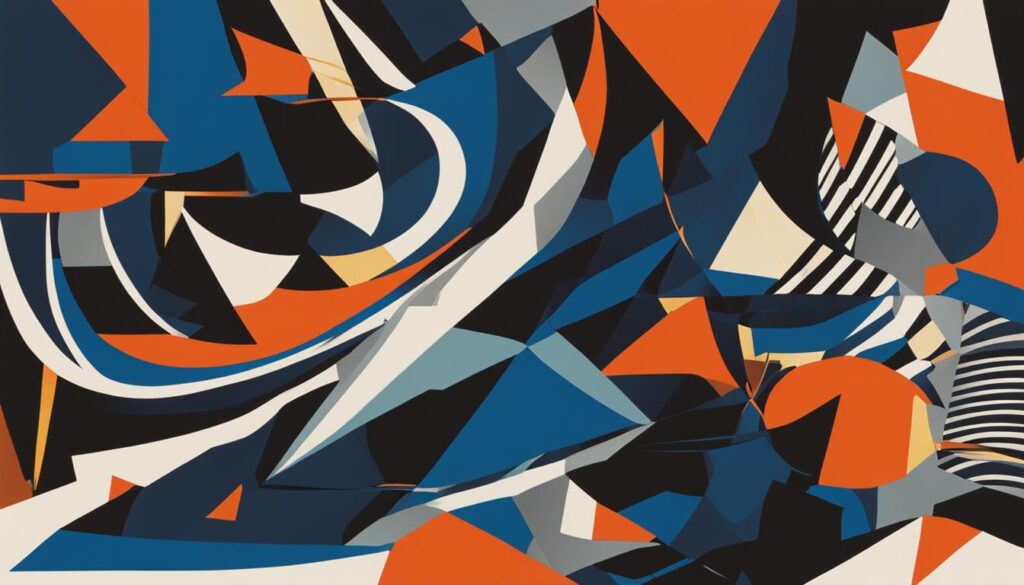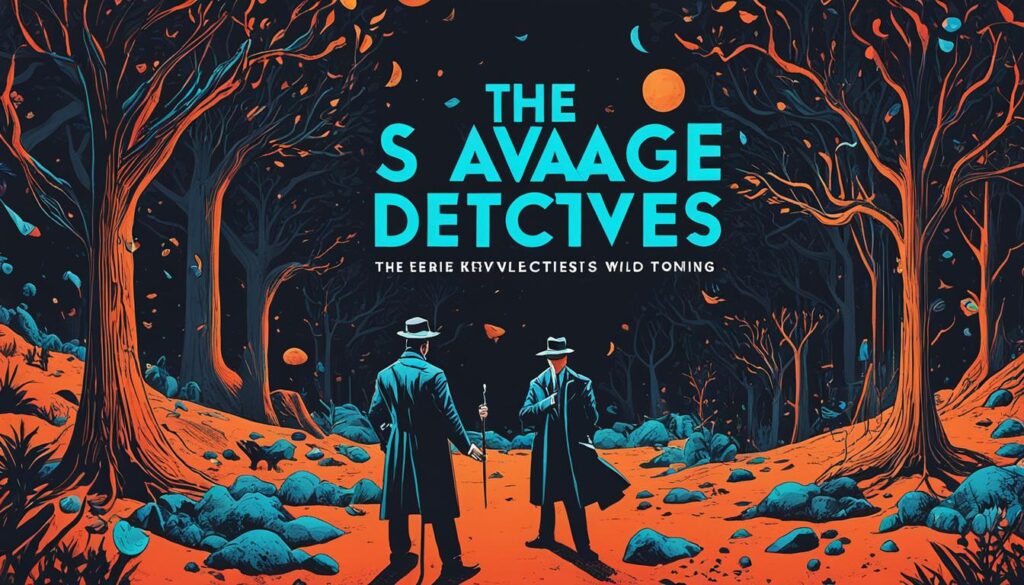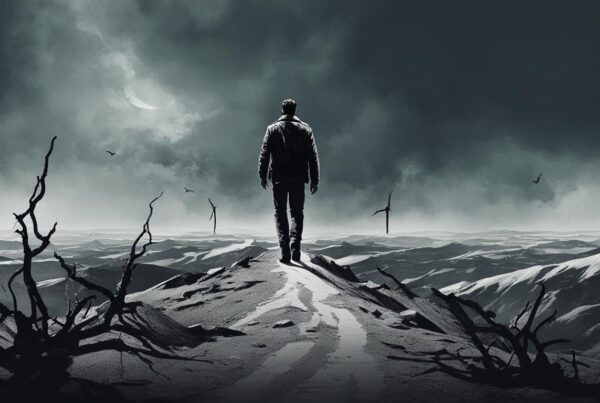Delving into the realm of literary wonders, Roberto Bolaño‘s The Savage Detectives stands out as a literary masterpiece that defies conventional storytelling with its intricate design and profound narrative. This novel has captivated readers and critics alike, securing its place as a cornerstone of modern literature. Today, it continues to enthrall not only in print but also through its auditory revival as an audiobook, inviting a comprehensive audiobook analysis of its delivery and impact on the experience of Bolaño’s timeless work.
The magnificence of Bolaño’s creation stems from his skillful blend of poetic prowess and narrative ambition, making The Savage Detectives a true testament to the enduring power of language and story. Through this review, we aim to dissect the nuances that make this book a continual source of academic and aesthetic admiration. Join us as we navigate the labyrinthine pages that have shaped the contours of contemporary literature.
An Introduction to Roberto Bolaño’s Masterpiece
Roberto Bolaño, a name that resonates with innovation in Latin American literature, left an indelible mark through his narrative talents and profound thematic involvements. His artworks bestow an unwavering impact on literary traditions, ensuring his contributions are continually analyzed and celebrated. This section aims to unwrap the layers of Bolaño’s life, the underpinnings of his famed novel “The Savage Detectives,” and the invented literary group that has intrigued readers worldwide: the Visceral Realist Movement.
Who was Roberto Bolaño?
Roberto Bolaño was an enigmatic figure whose life’s journey from Chile to the broad landscapes of Mexican and Spanish terrains paralleled the nomadic lives of his characters. His body of work is a testament to his life experiences, political views, and deep engagements with the essence of storytelling. Roberto Bolaño’s biography is a fascinating account of a writer who remained prolific till his untimely death, crafting narratives that challenged and expanded the horizons of Latin American literature.
The Significance of “The Savage Detectives”
“The Savage Detectives” is not merely a novel; it is a cornerstone that anchors Bolaño’s stature in the literary sphere. It builds with an unconventional rhythm that captures the zeitgeist of a generation lost between revolutions and existential quests. The literary significance of this work resonates through its piercing examination of youth, passion, and the inevitable decay of ideals. Through it, Bolaño weaves an intricate tapestry reflecting the complexities and contradictions that define the human condition.
Exploring the Visceral Realist Movement
The Visceral Realist Movement, though fictionalized by Bolaño, piques the interest of those who delve into the layers of “The Savage Detectives.” This movement, borne out of the imagination of a brilliant writer, alludes to the avant-garde quest for pure, unadulterated literary expression. The Visceral Realist Movement stands as a symbol of youthful defiance against the established cultural and literary paradigms, urging readers to question the boundaries of realism and the very nature of artistic creation within the novel.
“The Savage Detectives”: A Narrative Unlike Any Other
Roberto Bolaño’s “The Savage Detectives” stands as a beacon of literary innovation, ushering in a new era of storytelling with its unconventional narrative. Bolaño crafted a literary mosaic, stitching together a plethora of voices and perspectives, with each contributing a distinctive shade to the overarching narrative tapestry. This technique of multi-voiced storytelling is far from being just a stylistic choice; it serves as the novel’s very backbone, challenging the norms of linear storytelling and redefining the way stories can be told and experienced.
From the first page to the last, readers engage with a symphony of narrators, each bringing their own insights, biases, and humanity into the narrative. This complexity creates a reading experience that is both immersive and thought-provoking, beckoning readers to unravel the strands of Bolaño’s carefully constructed web. Below is a comparative analysis of traditional narrative structures versus the groundbreaking approach taken in “The Savage Detectives”:
| Traditional Narrative | The Savage Detectives |
|---|---|
| Single, reliable narrator | Sprawling cast of multi-layered narrators |
| Chronological timeline | Non-linear, fragmented timeline |
| Clear plot progression | Meandering, explorative plot threads |
| Defined beginning, middle, end | Cyclical and open-ended structure |
| Consistent storytelling style | Variety of styles, from diary entries to interviews |
What distinguishes Bolaño’s work as a novel of groundbreaking narrative form is not merely its structure, but how that structure informs and enriches the readers’ understanding of the characters, the world they inhabit, and the very essence of storytelling. The multiplicity of voices converges into a rich, polyphonic harmony, which transforms the act of reading into an active dialogue with the text. It is within this dialogue that the true genius of “The Savage Detectives” is realized – a masterpiece that continually reshapes the horizons of literary innovation.
Characters that Resonate: The Heart of Bolaño’s Novel
The intricate labyrinth of human experience and identity in Roberto Bolaño’s “The Savage Detectives” is vividly brought to life by its complex characters. These individuals are far more than just figments of imagination; they are embodiments of the Latin American culture and psyche, echoing, refracting, and sometimes dismantling the social and political realities of their times. The narrative is a testament to the sheer power of character development in literature.
The unforgettable Arturo Belano and Ulises Lima
At the novel’s core, Arturo Belano and Ulises Lima emerge as transcendent figures whose journeys captivate and mystify. Belano, a character often interpreted as Bolaño’s alter ego, and Lima, his enigmatic sidekick, lead us through a literary odyssey that unravels within the rich tapestry of Latin American narratives. Their quest strikes chords of longing and despair, which resonate through the chaos of life and art. The duo exemplifies the profound connection between the creator and the creation, as they navigate the world both within and beyond the confines of the book.
Secondary characters and their importance
The novel’s secondary characters, though not in the spotlight, are crucial in enriching the story. Each functions as a unique brushstroke, adding depth and perspective to the novel’s portrayal of an entire generation. These figures, from aspiring poets to lost lovers, represent the varied experiences and struggles throughout Latin America. Through them, Bolaño challenges readers to see the kaleidoscope of human existence, showing that everyone has a story worthy of being told.
The character ensemble and its reflection of Latin American culture
The interweaved lives of Bolaño’s characters form a microcosm of Latin American diversity and complexity. The intricate web of interpersonal relationships within the novel mirrors the interconnectedness of Latin America itself—a region marked by a tumultuous history, rich cultural heritage, and enduring societal challenges. As the characters traverse the landscapes of their lives, their stories collectively paint a picture that reveals as much about their inner worlds as it does about the external realities they inhabit.
The character development in “The Savage Detectives” leaves an indelible mark on the reader’s consciousness, proving that Bolaño’s craftsmanship goes far beyond mere storytelling. It is through these vivid, relatable, and sometimes heartbreaking figures that the essence of Latin American life pulses with undeniable authenticity and resonance, making “The Savage Detectives” a realm where characters truly become the beating heart of narrative art.
The Themes and Symbols in “The Savage Detectives”
The literary landscape of “The Savage Detectives” is intricately woven with a plethora of literary themes and motifs that span across the spectrum of human experience and intellectual discourse. At its heart, the novel serves as a profound cultural commentary, utilizing symbolism to explore the fabric of society and the individual’s place within it. The thematic content of Roberto Bolaño’s influential work extends beyond mere storytelling, providing a ground for political critique and introspection.
Quests for Meaning in a Disconnected World
In a narrative journey that takes readers through a vast array of perspectives and voices, Bolaño highlights an enduring quest for personal meaning within a world that seems increasingly fragmented and alienating. Characters navigate through the chaos of their realities, each seeking connection, understanding, and purpose amidst the cultural upheavals of the late 20th century. The relentless search for the elusive poet Cesárea Tinajero symbolizes this deep human craving to find coherence and significance in the midst of life’s disarray.
Literature and Art as Acts of Rebellion
The characters in “The Savage Detectives” often turn to literature and art as mechanisms of defiance against societal norms and constraints. Through his character’s vivid experiences, Bolaño proposes the idea that creativity can be an act of insurrection and liberation. The Visceral Realists, an avant-garde group of young poets at the core of the narrative, represent this rebellion—an attempt to seize control of their destinies and voices in a world that frequently attempts to silence or ignore them.
Political Undercurrents within the Narrative
A subtle yet potent thread of political undercurrents runs through the veins of the novel, manifesting as a backdrop to the personal stories and as a direct influence on the characters’ lives. Set against significant historical events that shaped Latin America, Bolaño embeds political discourse into the personal journeys of his protagonists, contemplating the role of politics in art, as well as the impact of societal and governmental forces on the individual’s freedom to express and exist.
In “The Savage Detectives,” symbolism is not merely an artistic device but a medium through which Bolaño paints a vivid tableau of existence that compels readers to reflect upon their own realities. The multifaceted layers of themes present in the novel serve as a mirror reflecting the tumultuous nature of human life and societal dynamics.
| Theme | Symbolism | Cultural Commentary |
|---|---|---|
| Search for Meaning | Cesárea Tinajero’s Poetry | Struggle with Personal Identity in Modern Society |
| Rebellion Through Art | Visceral Realists | Counterculture and the Disruption of Conventional Norms |
| Political Engagement | Latin American Turmoil | Interaction Between the Political Sphere and Individual Expression |
Structural Innovation in “The Savage Detectives”
In his novel “The Savage Detectives,” Roberto Bolaño shatters the conventional mold of narrative structure, employing what can only be described as innovative storytelling. This form of literary form challenges and complicates readers’ understanding, driving engagement through its complexity and novelty.
The fragmented, non-linear progression that defines the narrative structure of the novel invites readers to piece together the storyline in a way that feels personal and investigative. With a multitude of perspectives and timelines, the reader becomes an active participant in the narrative, constructing personal interpretations and links within the text. Below are key aspects of how this structural design redefines the literary experience:
- Fragmented Narration: The narrative is broken into varying segments that jump across time and space, emphasizing the theme of a chaotic search for meaning.
- Multiple Perspectives: The story is told through a chorus of voices, each adding depth and a unique angle to the unfolding events.
- Temporal Dislocation: The intentional disorientation of time compels readers to forgo the notion of a singular, sequential plot, instead engaging with the novel’s rhythmic and thematic harmonies.
This method of storytelling is not merely for aesthetic effect but acts as a potent literary device that mirrors the tumultuous journey of the characters themselves. Bolaño’s innovative storytelling amplifies the sense of adventure and the pursuit of truth, underscoring the novel’s exploration of reality and fiction.
Ultimately, “The Savage Detectives” stands as a testament to the enduring power of literary innovation. Bolaño’s distinctive narrative structure blurs the lines between the reader’s world and the textual world, forging an indelible impact on modern literature.
A Closer Look at Bolaño’s Writing Style and Language
The evolution of literature has been strikingly influenced by the distinctive prose and ingenious narrative techniques of Roberto Bolaño, a figure whose work continues to resonate in the study of contemporary fiction. An examination of Bolaño’s literary style offers insights into his significant impact on modern storytelling and the challenges faced in preserving his voice through the venture of literature in translation.
The impact of Bolaño’s prose on modern literature
In prose analysis, Bolaño’s literary style is often acclaimed for its intricate construction and an ability to convey profound philosophical inquiries. His narratives seamlessly weave together diverse character perspectives, presenting a multifaceted view of the world. This technique has not only mesmerized readers but also influenced fellow writers to adopt a similar introspective and explorative approach in their works, signifying Bolaño’s substantial imprint on literature.
Language as a Tool for Immersion and Disorientation
Language in Bolaño’s hands becomes a dual-edged sword, capable of delving the reader into deep immersion while simultaneously orchestrating moments of intentional disorientation. The intricacies of his language immersion techniques form part of the book’s unique allure, pulling readers into the vortex of his narrative while challenging their intellectual boundaries and perceptions of reality.
Translation: Capturing Bolaño’s Voice in English
To bring Bolaño’s evocative style to a wider audience, translators face the considerable task of transporting his rich linguistic tapestry from Spanish to English. Literature in translation aims to maintain the original’s essence, a challenging endeavor that has produced varying degrees of success. Accessibility to Bolaño’s narratives is thus broadened, yet the nuanced task of capturing his original voice is an ongoing dialogue amongst translators and readers alike.

| Element of Bolaño’s Style | Impact on Reader’s Experience | Considerations in Translation |
|---|---|---|
| Complex narrative structure | Engages readers in active interpretation | Rendering the structural complexity into the target language |
| Use of colloquial language | Creates authenticity and regional flavor | Translating idiomatic expressions while retaining meaning |
| Poetic descriptions | Evokes vivid imagery and emotions | Maintaining poetic rhythm and imagery across languages |
| Philosophical discourse | Stimulates intellectual engagement | Faithfully conveying abstract concepts and theories |
Critical Reception and Academic Perspectives
The arrival of “The Savage Detectives” on the literary scene was met with a rich tapestry of critical response, its complex layers of meaning dissected by scholars and critics alike. The intricate dance between the fervent embrace of postmodern literature analysis and the scrupulous eye of literary criticism reveals the novel’s vibrant academic reception. Roberto Bolaño’s magnum opus not only captivated readers but also sparked vibrant discussions that resonated throughout the halls of academia.
Initial reception and reviews of “The Savage Detectives”
Upon publication, the novel was lauded for its innovative narrative structure and its powerful portrayal of disenchantment. Critics heaped praise on Bolaño for his ability to capture the ethos of a generation adrift, earning “The Savage Detectives” a distinguished place in the annals of postmodern literature. The initial reviews highlighted the book’s audacity, its intertextuality and for many, it epitomized a landmark in the tradition of Latin American storytelling.
The novel’s place in contemporary literature courses
Universities quickly recognized the novel’s significance, incorporating it into contemporary literature syllabi. “The Savage Detectives” now serves as a prism through which students explore a variety of themes, from the quest for identity in a globalized world to the very nature of artistic creation. Professors prize the text for its rich context and utility as a teaching aid in unraveling the intricacies of postmodern narrative techniques.
Comparisons to other postmodern works
In drawing parallels between Bolaño’s work and other pillars of postmodernism, scholars reveal shared motifs of fragmentation, metafiction, and unreliable narration. “The Savage Detectives” often finds itself in conversation with the likes of “Infinite Jest” by David Foster Wallace and “Hopscotch” by Julio Cortázar, displaying a kinship in their disruption of linear storytelling and their reflective commentary on the act of writing itself.
| Aspect | “The Savage Detectives” | Comparative Postmodern Works |
|---|---|---|
| Narrative Structure | Non-linear, multi-narrator | Typically fragmented with various narrative techniques |
| Themes | Search for identity, art as rebellion | Common postmodern themes of metafiction and hyperreality |
| Critical Reception | Widely acclaimed for innovation | Mixed; some celebrated, others controversial |
| Academic Usage | Frequently studied in literature courses | Varies; some are staples, others more niche |
The dialogue surrounding “The Savage Detectives” continues to evolve, as new generations of critics and students delve into its pages. Whether examining through the lens of literary criticism, discussing in the context of academic reception, or dissecting via postmodern literature analysis, the novel persists as an object of fascination and study. The result is an ever-expanding body of work that pays homage to Bolaño’s enduring legacy within the literary canon.
The Influence of “The Savage Detectives” on Later Writers
Reflecting on the immense literary influence that “The Savage Detectives” has exerted, it’s clear that Roberto Bolaño’s groundbreaking work has become a seminal touchstone for contemporary writers. The novel’s non-linear narrative, complex character constellation, and thematic explorations of exile and search for identity have carved a significant space in post-Bolaño literature, shaping the narrative forms and stylistic choices of authors around the globe.
This legacy is evident as modern writers frequently draw parallels to Bolaño’s narrative strategies and thematic concerns, citing “The Savage Detectives” as inspiration for pushing the boundaries of literary conventions. Here, we examine some specific examples of how the novel’s influence has manifested in the works of subsequent writers.
- Hybrid narrative forms: Emulating Bolaño’s blend of genres, contemporary authors have felt emboldened to mix memoir with fiction, poetry with prose, creating rich and multifaceted works.
- Collective storytelling: Following Bolaño’s lead, writers have crafted novels that are comprised of multiple voices to capture a more complete, albeit sometimes fragmented, vision of reality.
- Interrogations of history: Echoing Bolaño’s preoccupation with the past, today’s writers have continued dedicating narrative space to the examination of historical events and their impacts on the present.
“Not only did ‘The Savage Detectives’ revolutionize the way stories could be told, but it also gave writers the permission to explore the very limits of language and form.”
The subsequent table illustrates the attributes of Bolaño’s work and notable examples of their influence in modern literature:
| Attribute of “The Savage Detectives” | Examples of Influence in Contemporary Literature |
|---|---|
| Narrative Innovation | Modern novels that utilize a fragmented or collage-style structure |
| Multitude of Voices | Literary works featuring a diverse array of character perspectives |
| Exploration of Exile | Stories that delve deeply into the theme of displacement and identity |
| Metafictional Elements | Novels where the line between fact and fiction is purposefully blurred |
| Political and Social Critique | Works that unabashedly confront and comment on contemporary issues |
In these ways and more, “The Savage Detectives” continues to resonate with and inspire a new generation of writers and readers, maintaining its revered status as a beacon of literary innovation and a catalyst for continuing evolution in the world of letters.
The Savage Detectives Audiobook Review
In the growing world of literary audiobooks, the auditory incarnation of Roberto Bolaño’s The Savage Detectives stands as a monumental endeavor. Capturing the essence and rhythmic pulse of Bolaño’s prose, the audiobook format presents a unique listening experience that warrants a comprehensive review.
Auditory Experience vs. Reading: The Narration’s Impact
The intrinsic qualities of Bolaño’s narrative are heightened when conveyed through the spoken word. As a sensory experience, the audiobook draws listeners into a nuanced soundscape wherein the characters’ lives unfold with dramatic vividness. An audiobook review must, therefore, consider not only the content but also the affective dimensions of the listening experience.
Performance and Interpretation by the Audiobook Narrator
The narration analysis reveals the essential role of the narrator in shaping the story’s reception. Through tone, cadence, and emotional resonance, the narrator’s interpretation can enhance Bolaño’s already complex characters and breathe new life into the novel’s powerful themes. Audiobook performance, in many ways, becomes its own art form, with spoken words transforming the listener’s understanding of Bolaño’s intent.
The Immersive Experience of Listening to Bolaño
An audiobook’s performance can create an immersive experience that surpasses traditional reading, and in the case of The Savage Detectives, this proves especially true. Listeners report a deepened connection to the narrative, experiencing the landscapes and dialogues with an immediacy that print cannot always convey. The listening experience fosters an intimate engagement with Bolaño’s material, making the audiobook a compelling companion to the written text.

| Aspect | Audiobook Experience | Traditional Reading |
|---|---|---|
| Engagement | Highly immersive, draws listener into auditory world | Immersive through imagination and personal pace |
| Narrative Interpretation | Shaped by narrator’s performance and vocal nuances | Interpreted by reader’s internal voice and perception |
| Accessibility | Allows for multitasking and access for those unable to read print | Requires full attention and ability to read text |
| Emotional Connection | Can be heightened by a skilled narrator’s emotional delivery | Dependent on reader’s emotional imagination |
Conclusion
As we encapsulate the literary journey we’ve undertaken in exploring “The Savage Detectives,” it is evident that Roberto Bolaño’s masterpiece has carved an indelible niche in the annals of literary history. The myriad of literary insights gleaned from this narrative showcase not only a deep understanding of form and structure but also a profound commentary on human experience. From the vibrant portraits of Arturo Belano and Ulises Lima to the intricate web of narratives that form its structure, Bolaño’s work remains a touchstone for the transformative power of literature.
Our final thoughts on Bolaño are a testimony to his remarkable ability to wed innovation with literary tradition, thereby establishing a new paradigm for writers and readers alike. His narrative, rich in complexity and brimming with thematic depth, transcends conventional storytelling and embarks upon an exploration of existence that is both timeless and immediate. Whether encountered through the tactile pages of a book or the evocative voice of an audiobook narrator, “The Savage Detectives” endures as a testament to Bolaño’s visionary genius.
The audiobook conclusions affirm that the oral rendition brings a unique dimension to Bolaño’s work, enhancing its accessibility and reach. The journey is not solely through the streets of Mexico City but through the expansive terrains of human consciousness, delivered through a medium that taps into the power of the spoken word. Thus, “The Savage Detectives,” both as a reading and listening experience, secures its place not just in the realm of Latin American literature but the global literary canon, resonating with a chorus of voices and echoes that continue to inspire and captivate.



